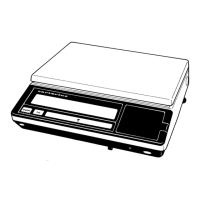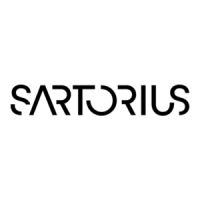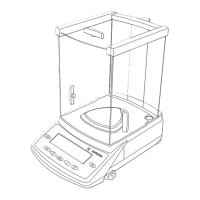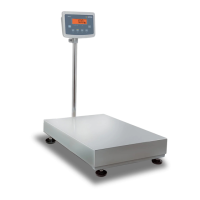Do you have a question about the Sartorius LP Models and is the answer not in the manual?
Explains the function of various keys and their assignment based on the operating mode.
Describes the six sections of the balance display and their respective functions.
Details the steps for entering numbers and letters using the balance keypad.
Explains how to navigate menus to set balance parameters and configurations.
Outlines data interface capabilities and connecting peripheral devices.
Explains error indications, how settings are stored, and password protection.
Instructions for warranty registration, unpacking, and checking for shipping damage.
Guidance on selecting an optimal location and acclimating the balance.
Lists components and their order for setting up balances with a round glass draft shield.
Details components for rectangular pans up to 12 kg and for heavier balances.
Instructions on how to detach and reposition the display unit for separate operation.
Describes alternative mounting positions for the display unit on heavier balances.
Steps to connect power, safety precautions, and connecting peripherals.
Explains the required warm-up time for accurate results after power connection.
Instructions on how to secure the balance using an antitheft locking device.
Explains the purpose and procedure for leveling the balance for consistent results.
Explains how to configure the balance using user data and setup menus.
Guides on selecting the display language and accessing equipment information.
Instructions on how to input and change user-specific data like workstation or lot IDs.
Detailed guide on setting, changing, or recovering the balance's password.
Step-by-step guide to entering 'Workstation 234' as Balance ID and displaying user data.
Continuation of the practical example showing lot number and other user data display.
Explains how to configure balance settings by navigating through menu options.
How to print parameter settings or access other additional functions within the menu.
Demonstrates selecting the Counting Application Program through the setup menu.
Outlines configurable parameters under Level 1: Balance Functions.
Details configurable parameters under Level 1: Application Programs.
Lists configurable parameters under Level 1: Application Parameters.
Details parameters related to balance functions like display, keys, and calibration.
Lists available application programs and parameters for their configuration.
Covers application parameters like counting/percent settings and interface configuration.
Configuration options for +/- parameters, interface settings, and communication modes.
Details interface settings like parity, handshake, and options for printing weighing data.
Settings for printing application parameters, line format, and extra functions.
Details settings for acoustic signals, blocking keys, power-on mode, and balance menu.
Explains the fundamental weighing operation, taring, and ID assignment.
Describes how to use the port for below-balance weighing with appropriate accessories.
How to assign and format weight IDs for documentation purposes.
Lists additional functions accessible from weighing, and how to turn off the balance.
Step-by-step guide for entering and storing a sample ID (ABC123).
Defines calibration and adjustment and lists features for external and internal calibration.
Procedure to enable external calibration and notes on factory calibration settings.
Guides on configuring parameters for calibration and adjustment.
Steps to set parameters for calibration functions within the setup menu.
Explains how to select calibration modes like external or internal adjustment.
Demonstrates the process of configuring external calibration and automatic adjustment.
Detailed guide on performing external calibration using a user-defined weight.
Steps to input and save a custom calibration weight value.
Explains how to perform internal calibration using the balance's built-in weight.
How to configure the sequence of calibration and adjustment operations.
Details the automatic calibration feature, its triggers, and configuration options.
How to disable automatic calibration for verified balances under specific conditions.
Defines repeatability and explains the function of reproTEST in calculating results.
Practical steps to perform and end the reproTEST measurement.
Overview of application programs and their use in legal metrology.
How to switch between different weight units using a soft key.
Steps to set primary/secondary weight units and display accuracy.
Lists additional functions and balance control options within applications.
Demonstrates toggling between Grams and Troy Ounces.
Purpose and features of the counting application for determining piece counts.
Lists features of the counting program and its default factory settings.
How to prepare for piece count calculation and update the reference sample.
Steps to configure counting parameters like storage accuracy and auto-initialization.
Demonstrates counting with preset reference sample quantity and printing parameters.
Explains the application for obtaining weight readouts as a percentage of a reference weight.
Lists features of the weighing in percent program and its default factory settings.
How to prepare for calculating values in percent by entering reference percentage or weight.
Steps to configure parameters for the weighing-in-percent application.
Demonstrates weighing in percent using a reference weight taken from the balance.
Demonstrates weighing in percent with reference weight entered using numeric keys.
Explains weighing multiple components to a defined total and printing weights.
How to prepare for the net-total application and configure its parameters.
Demonstrates weighing several components using the net-total application.
Explains determining weights of unstable samples or under unstable conditions.
Lists features of the animal weighing program and its default factory settings.
How to prepare for the animal weighing application by selecting it in the setup menu.
Steps to configure parameters like start range and printout options for animal weighing.
Demonstrates determining animal weight with automatic start of subweighing operations.
Continues the animal weighing example showing subweighing operations and results.
Explains checking if a sample meets a target value within a tolerance range.
Lists features of checkweighing, including tolerance limits and factory settings.
How to prepare for checkweighing by defining target value and tolerance range.
Explains control line behavior and details output port specifications.
How to prepare for the over/under checkweighing application.
Steps to configure parameters like auto-initialization and control line signals.
Demonstrates checkweighing with specified tolerance limits and auto printing.
Continues the checkweighing example, showing storage of limits and weighing samples.
Explains compensating for over-poured components in formulation.
Lists features of the recalculation program and its default factory settings.
How to prepare for the recalculation application.
Steps to configure automatic printout and line format for recalculation.
Demonstrates recalculation when a component is over-poured in formulation.
Continues recalculation example, showing value correction and follow-on filling.
Concludes recalculation example with final component addition and total weight printing.
Explains the six sections of the balance display for data output.
Details information shown on the metrological data line for verified instruments.
How weighing results are displayed on the bar graph and in the measured value line.
Explains weight unit, symbol displays, and their meanings.
Content of the text line and how values exceeding 8 characters are displayed.
Explains how to generate printouts of weights, values, and identification numbers.
Lists features for manual/automatic printing, line format, and application parameters.
How to manually or automatically print current values in various formats.
How to configure data ID codes, text preceding printouts, and sample IDs.
How to print initialization values for applications.
How to automatically print weight readouts and net-total values.
Automatic printing of animal weight and checkweighing results.
How to configure scale output for legal-for-trade applications.
How to print parameters related to ambient weighing conditions for GLP compliance.
Details the features of the Sartorius Data Printer for ISO/GLP records.
Explains the balance's interface port for connecting computers or peripheral devices.
Critical warning about incorrect pin assignments on non-Sartorius RS-232 cables.
Default factory settings for interface parameters like transmission rate and parity.
Explains how to output values with or without a data ID code in different formats.
Lists special codes and how error codes are represented in data output.
Explains unit symbols, ID code characters, and their meanings.
Provides a breakdown of special codes for status, overload, and error code references.
Explains how to send commands to the balance via the interface port.
Details the different formats and characters used for control commands.
Explains how to ensure error-free data communication via the interface.
How XON/XOFF signals control data transmission and reception.
How to define data output activation based on print commands or intervals.
How to configure automatic data output based on intervals or stability.
Details the pinout for the female DB25S interface connector.
Lists pin functions for signal ground, data output, and control signals.
Specifies male connector type and detailed pin assignments for interface functions.
Illustrates the cabling connection between the balance and a PC using RS-232.
How to block access to settings and input functions by assigning a password.
How to configure acoustic signals and block keys for remote control operation.
Connecting remote switches, managing display backlight, and power-on modes.
How to configure automatic shutoff after a period of inactivity.
Connecting external devices like checkweighing displays and remote switches.
How to configure printouts to comply with ISO/GLP standards.
Explains connecting devices using the MP8 interface protocol.
Details configuring application selection, baud rate, parity, and print settings.
Lists common error codes, their causes, and troubleshooting steps.
Details further error codes related to printer, reference weight, and input issues.
Troubleshooting for continuous display segments, blocked functions, and unstable readouts.
Importance of regular service, authorized repairs, and safe cleaning procedures.
Instructions for replacing a damaged dust cover on different balance models.
Guidelines for checking the AC adapter and balance for safe operation.
Information on replacing the backup battery, including type and safety precautions.
Guidance on recycling the balance packaging and old equipment.
Illustrates balance components and provides order numbers for spare parts.
Detailed illustration and part numbers for various Sartorius balance models.
Illustrations and part numbers for specific Sartorius balance models (LP64001S series).
Explains the purpose and operation of each key on the balance's control panel.
Provides a hierarchical overview of the balance's menu structure and parameters.
Lists general specifications like power, environment, interface, and selectable units/programs.
Details readability, capacity, tare range, and linearity for specific models.
Details specifications for various models, including response time and calibration weights.
Lists specifications for additional models, covering capacity and environmental ranges.
Lists general specifications for verified models, including accuracy class and scale interval.
Details specifications for verified models, including capacity and operating temperature.
Lists specifications for verified models, covering accuracy class, capacity, and operating ranges.
Lists specifications for the highest capacity verified models, including dust/water protection.
Lists available optional accessories like data printers and rechargeable battery packs.
Details printers, battery packs, remote displays, checkweighing displays, and calibration weights.
Lists software, operating procedures, and adapters as optional products.
Details remote controls, switches, cables, support arms, and weighing bowls.
Explains the CE mark and Sartorius AG's compliance with EC Directives.
Details EMC standards and acceptable European standards for emissions and immunity.
Covers safety requirements for electrical equipment and general installation provisions.
Explains Directive 90/384/EEC for non-automatic weighing instruments and EC Type-Approval Certificates.
Describes the initial verification and installation services provided by Sartorius.
Details the EC verification service performed by authorized Sartorius technicians.
Information on the validity of verification and regulations for subsequent verifications.
Official declaration of conformity for weighing instruments used in legal metrology.
Lists balance models, their types, and EC Type-Approval numbers.
Sartorius AG's statement of compliance with relevant directives and standards.
Official EC type-approval certificate issued by PTB for the weighing instrument.
Test certificate details for the weighing platform, including type and revision.
Test certificate details for the weighing platform with electronic evaluation unit.
Details the CE mark, EC verification, model designation, and other important labels on the balance.
Information about different types of indicating and operator terminals.
Example of a verified weighing instrument's descriptive plate.
Instructions on how to enter or change the general password.
Explains the function of various keys and their assignment based on the operating mode.
Describes the six sections of the balance display and their respective functions.
Details the steps for entering numbers and letters using the balance keypad.
Explains how to navigate menus to set balance parameters and configurations.
Outlines data interface capabilities and connecting peripheral devices.
Explains error indications, how settings are stored, and password protection.
Instructions for warranty registration, unpacking, and checking for shipping damage.
Guidance on selecting an optimal location and acclimating the balance.
Lists components and their order for setting up balances with a round glass draft shield.
Details components for rectangular pans up to 12 kg and for heavier balances.
Instructions on how to detach and reposition the display unit for separate operation.
Describes alternative mounting positions for the display unit on heavier balances.
Steps to connect power, safety precautions, and connecting peripherals.
Explains the required warm-up time for accurate results after power connection.
Instructions on how to secure the balance using an antitheft locking device.
Explains the purpose and procedure for leveling the balance for consistent results.
Explains how to configure the balance using user data and setup menus.
Guides on selecting the display language and accessing equipment information.
Instructions on how to input and change user-specific data like workstation or lot IDs.
Detailed guide on setting, changing, or recovering the balance's password.
Step-by-step guide to entering 'Workstation 234' as Balance ID and displaying user data.
Continuation of the practical example showing lot number and other user data display.
Explains how to configure balance settings by navigating through menu options.
How to print parameter settings or access other additional functions within the menu.
Demonstrates selecting the Counting Application Program through the setup menu.
Outlines configurable parameters under Level 1: Balance Functions.
Details configurable parameters under Level 1: Application Programs.
Lists configurable parameters under Level 1: Application Parameters.
Details parameters related to balance functions like display, keys, and calibration.
Lists available application programs and parameters for their configuration.
Covers application parameters like counting/percent settings and interface configuration.
Configuration options for +/- parameters, interface settings, and communication modes.
Details interface settings like parity, handshake, and options for printing weighing data.
Settings for printing application parameters, line format, and extra functions.
Details settings for acoustic signals, blocking keys, power-on mode, and balance menu.
Explains the fundamental weighing operation, taring, and ID assignment.
Describes how to use the port for below-balance weighing with appropriate accessories.
How to assign and format weight IDs for documentation purposes.
Lists additional functions accessible from weighing, and how to turn off the balance.
Step-by-step guide for entering and storing a sample ID (ABC123).
Defines calibration and adjustment and lists features for external and internal calibration.
Procedure to enable external calibration and notes on factory calibration settings.
Guides on configuring parameters for calibration and adjustment.
Steps to set parameters for calibration functions within the setup menu.
Explains how to select calibration modes like external or internal adjustment.
Demonstrates the process of configuring external calibration and automatic adjustment.
Detailed guide on performing external calibration using a user-defined weight.
Steps to input and save a custom calibration weight value.
Explains how to perform internal calibration using the balance's built-in weight.
How to configure the sequence of calibration and adjustment operations.
Details the automatic calibration feature, its triggers, and configuration options.
How to disable automatic calibration for verified balances under specific conditions.
Defines repeatability and explains the function of reproTEST in calculating results.
Practical steps to perform and end the reproTEST measurement.
Overview of application programs and their use in legal metrology.
How to switch between different weight units using a soft key.
Steps to set primary/secondary weight units and display accuracy.
Lists additional functions and balance control options within applications.
Demonstrates toggling between Grams and Troy Ounces.
Purpose and features of the counting application for determining piece counts.
Lists features of the counting program and its default factory settings.
How to prepare for piece count calculation and update the reference sample.
Steps to configure counting parameters like storage accuracy and auto-initialization.
Demonstrates counting with preset reference sample quantity and printing parameters.
Explains the application for obtaining weight readouts as a percentage of a reference weight.
Lists features of the weighing in percent program and its default factory settings.
How to prepare for calculating values in percent by entering reference percentage or weight.
Steps to configure parameters for the weighing-in-percent application.
Demonstrates weighing in percent using a reference weight taken from the balance.
Demonstrates weighing in percent with reference weight entered using numeric keys.
Explains weighing multiple components to a defined total and printing weights.
How to prepare for the net-total application and configure its parameters.
Demonstrates weighing several components using the net-total application.
Explains determining weights of unstable samples or under unstable conditions.
Lists features of the animal weighing program and its default factory settings.
How to prepare for the animal weighing application by selecting it in the setup menu.
Steps to configure parameters like start range and printout options for animal weighing.
Demonstrates determining animal weight with automatic start of subweighing operations.
Continues the animal weighing example showing subweighing operations and results.
Explains checking if a sample meets a target value within a tolerance range.
Lists features of checkweighing, including tolerance limits and factory settings.
How to prepare for checkweighing by defining target value and tolerance range.
Explains control line behavior and details output port specifications.
How to prepare for the over/under checkweighing application.
Steps to configure parameters like auto-initialization and control line signals.
Demonstrates checkweighing with specified tolerance limits and auto printing.
Continues the checkweighing example, showing storage of limits and weighing samples.
Explains compensating for over-poured components in formulation.
Lists features of the recalculation program and its default factory settings.
How to prepare for the recalculation application.
Steps to configure automatic printout and line format for recalculation.
Demonstrates recalculation when a component is over-poured in formulation.
Continues recalculation example, showing value correction and follow-on filling.
Concludes recalculation example with final component addition and total weight printing.
Explains the six sections of the balance display for data output.
Details information shown on the metrological data line for verified instruments.
How weighing results are displayed on the bar graph and in the measured value line.
Explains weight unit, symbol displays, and their meanings.
Content of the text line and how values exceeding 8 characters are displayed.
Explains how to generate printouts of weights, values, and identification numbers.
Lists features for manual/automatic printing, line format, and application parameters.
How to manually or automatically print current values in various formats.
How to configure data ID codes, text preceding printouts, and sample IDs.
How to print initialization values for applications.
How to automatically print weight readouts and net-total values.
Automatic printing of animal weight and checkweighing results.
How to configure scale output for legal-for-trade applications.
How to print parameters related to ambient weighing conditions for GLP compliance.
Details the features of the Sartorius Data Printer for ISO/GLP records.
Explains the balance's interface port for connecting computers or peripheral devices.
Critical warning about incorrect pin assignments on non-Sartorius RS-232 cables.
Default factory settings for interface parameters like transmission rate and parity.
Explains how to output values with or without a data ID code in different formats.
Lists special codes and how error codes are represented in data output.
Explains unit symbols, ID code characters, and their meanings.
Provides a breakdown of special codes for status, overload, and error code references.
Explains how to send commands to the balance via the interface port.
Details the different formats and characters used for control commands.
Explains how to ensure error-free data communication via the interface.
How XON/XOFF signals control data transmission and reception.
How to define data output activation based on print commands or intervals.
How to configure automatic data output based on intervals or stability.
Details the pinout for the female DB25S interface connector.
Lists pin functions for signal ground, data output, and control signals.
Specifies male connector type and detailed pin assignments for interface functions.
Illustrates the cabling connection between the balance and a PC using RS-232.
How to block access to settings and input functions by assigning a password.
How to configure acoustic signals and block keys for remote control operation.
Connecting remote switches, managing display backlight, and power-on modes.
How to configure automatic shutoff after a period of inactivity.
Connecting external devices like checkweighing displays and remote switches.
How to configure printouts to comply with ISO/GLP standards.
Explains connecting devices using the MP8 interface protocol.
Details configuring application selection, baud rate, parity, and print settings.
Lists common error codes, their causes, and troubleshooting steps.
Details further error codes related to printer, reference weight, and input issues.
Troubleshooting for continuous display segments, blocked functions, and unstable readouts.
Importance of regular service, authorized repairs, and safe cleaning procedures.
Instructions for replacing a damaged dust cover on different balance models.
Guidelines for checking the AC adapter and balance for safe operation.
Information on replacing the backup battery, including type and safety precautions.
Guidance on recycling the balance packaging and old equipment.
Illustrates balance components and provides order numbers for spare parts.
Detailed illustration and part numbers for various Sartorius balance models.
Illustrations and part numbers for specific Sartorius balance models (LP64001S series).
Explains the purpose and operation of each key on the balance's control panel.
Provides a hierarchical overview of the balance's menu structure and parameters.
Lists general specifications like power, environment, interface, and selectable units/programs.
Details readability, capacity, tare range, and linearity for specific models.
Details specifications for various models, including response time and calibration weights.
Lists specifications for additional models, covering capacity and environmental ranges.
Lists general specifications for verified models, including accuracy class and scale interval.
Details specifications for verified models, including capacity and operating temperature.
Lists specifications for verified models, covering accuracy class, capacity, and operating ranges.
Lists specifications for the highest capacity verified models, including dust/water protection.
Lists available optional accessories like data printers and rechargeable battery packs.
Details printers, battery packs, remote displays, checkweighing displays, and calibration weights.
Lists software, operating procedures, and adapters as optional products.
Details remote controls, switches, cables, support arms, and weighing bowls.
Explains the CE mark and Sartorius AG's compliance with EC Directives.
Details EMC standards and acceptable European standards for emissions and immunity.
Covers safety requirements for electrical equipment and general installation provisions.
Explains Directive 90/384/EEC for non-automatic weighing instruments and EC Type-Approval Certificates.
Describes the initial verification and installation services provided by Sartorius.
Details the EC verification service performed by authorized Sartorius technicians.
Information on the validity of verification and regulations for subsequent verifications.
Official declaration of conformity for weighing instruments used in legal metrology.
Lists balance models, their types, and EC Type-Approval numbers.
Sartorius AG's statement of compliance with relevant directives and standards.
Official EC type-approval certificate issued by PTB for the weighing instrument.
Test certificate details for the weighing platform, including type and revision.
Test certificate details for the weighing platform with electronic evaluation unit.
Details the CE mark, EC verification, model designation, and other important labels on the balance.
Information about different types of indicating and operator terminals.
Example of a verified weighing instrument's descriptive plate.
Instructions on how to enter or change the general password.
| Category | Scales |
|---|---|
| Brand | Sartorius |
| Model | LP Models |
| Display | LCD |
| Calibration | External |
| Interface | RS-232 |
| Power Supply | AC Adapter |
| Material | Stainless Steel Pan |
| Protection Class | IP43 |











